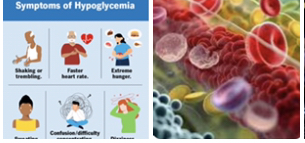
People without diabetes can get low blood sugar
People without diabetes can get hypoglycemia, or low blood sugar.
This can happen if you take certain medications, have a severe infection, or have other serious issues affecting your organs.
Hypoglycemia is a condition that occurs when the sugar levels (glucose) in your blood are too low.
Many people think of hypoglycemia as something that occurs only in people with diabetes. However, it can also occur in people who don’t have diabetes.
Everyone reacts differently to fluctuations in their blood sugar levels.
Symptoms of hypoglycemia may include:dizziness, sweating
shaking, blurred vision, pale skin,extreme hunger,headache, confusion, inability to concentrate and many more .
You may have hypoglycemia without symptoms. This is known as hypoglycemia unawareness.
While Diabetes is a disease that affects how your body uses sugar. This sugar, or glucose, is essential to your health and everyday living.
If you have diabetes, you’re probably used to limiting your added sugar intake. Many people with diabetes may think that all-natural sweeteners are healthier than sugar replacements
Your body’s cells derive their energy from it. This sugar helps fuel muscles and other tissues, including the brain.
Without properly managing your glucose, your blood sugar levels may climb too high or fall too low.
If your blood glucose level is too high, you have hyperglycemia. If you have hypoglycemia, your blood sugar levels are too low.
Your blood carries glucose around your body to supply fuel for your body’s functions.
A hormone called insulin moves the sugar from your blood into your cells, where your body converts it to energy.
Your pancreas produces insulin. If you have diabetes, your body either doesn’t have enough insulin or the insulin doesn’t work properly.
Either way, the glucose can’t get into your cells. This affects your body’s ability to function properly. The glucose can also build up in your blood, leading to high blood sugar levels.
The main types of diabetes are types 1 and 2.
Type 1 diabetes is sometimes called juvenile-onset diabetes because it often develops in childhood.
Type 1 diabetes can also develop in adults. Type 1 diabetes occurs when your pancreas cannot make enough insulin.
Type 2 diabetes is more likely to develop in people who are inactive or overweight.
If you have type 2 diabetes, your body has developed a resistance to insulin, which means your cells don’t use insulin properly. Your body produces more insulin as a response to this resistance.
At first, your pancreas can keep up with the additional need. Insulin production may slow, and the pancreas may be unable to keep up with your body’s insulin demands. If that happens, your blood glucose levels may climb too high.
You’ll then need to treat your diabetes with medications or supplemental insulin. Eating a healthy diet and exercising regularly are key steps in managing diabetes.
The longer you have diabetes and the longer it’s left untreated, the higher your chances of developing serious health complications.
If your high blood sugar is not properly treated and managed, you may experience the following issues:
Blood sugar levels that are too high can damage the tiny blood vessels and nerves in your body. This can lead to decreased blood flow. Eventually, you may experience tingling or numbness.
Nerve damage, also called neuropathy, is most common in your extremities but can develop anywhere.
Like other parts of your body, high blood sugar levels in your kidneys can damage their tiny vessels. As a result, your kidneys may not work as well as they should. This can lead to kidney damage and kidney failure.
Neuropathy in your feet and poor circulation may increase the risk of foot injuries going undetected and possible infection.
If you develop an infection from a cut or sore, diabetes makes healing difficult. In severe cases, people with advanced diabetes may need surgery to remove toes or portions of their feet.
People with diabetes have an increased risk for cardiovascular problems, including: Heart attack,Stroke,Heart failure.
They also have an increased risk for atherosclerosis or hardening of the arteries.
Why your diet matter, It’s often assumed that all people with diabetes must follow a strict diet.
There isn’t one specific eating plan that works for every person, though. Instead, you should follow a set of principles regarding meal planning.
For example, try to eat a more plant-based diet. An eating plan rich in fruits, vegetables, and whole grains will be naturally high in fiber, vitamins, and minerals.
You should also opt for lower fat animal products. Lean meats are better than fattier cuts. Pick lower fat milk and milk products, such as cheese and yogurt, when possible.
Some additional tips for meal planning:Sugar isn’t off-limits for people with diabetes, but you should be careful about what you eat and how often.
Foods high in refined carbohydrates and added sugars can increase blood glucose levels. They also aren’t good sources of any other nutrition.
Focus on healthier sources of carbohydrates, such as:whole grains,
beans, Starchy vegetables, lentils,
Swap in some fish.
Instead of chicken, pork, and beef, add fish to your menu about three times a week. Fish is a protein source that’s rich in healthy fats and vitamins.
Avoid fried fish, which adds unnecessary fat, carbs, and calories to your meal. Stick to grilled, baked, and seared fish.
Seek out healthy, unsaturated fats. Limit your intake of unhealthy saturated and trans fats. Healthy fats come from plants in the form of:oils, nuts, seeds, avocado, olives.
Unhealthy fats, including those in butter and cheese, mainly come from animal sources. Aim to check ingredient labels for details regarding the nutrition of processed foods.
Eating too many of them can increase your risk of developing certain health conditions.

.webp)
